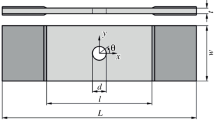Abstract
This paper concerns the numerical characterization of the fatigue strength of a flat stiffened panel, designed as a fiber metal laminate (FML) and made of Aluminum alloy and Fiber Glass FRP. The panel is full scale and was tested (in a previous work) under fatigue biaxial loads, applied by means of a multi-axial fatigue machine: an initial through the thickness notch was created in the panel and the aforementioned biaxial fatigue load applied, causing a crack initiation and propagation in the Aluminum layers. Moreover, (still in a previous work), the fatigue test was simulated by the Dual Boundary Element Method (DBEM) in a bidimensional approach. Now, in order to validate the assumptions made in the aforementioned DBEM approach and concerning the delamination area size and the fiber integrity during crack propagation, three-dimensional BEM and FEM submodelling analyses are realized. Due to the lack of experimental data on the delamination area size (normally increasing as the crack propagates), such area is calculated by iterative three-dimensional BEM or FEM analyses, considering the inter-laminar stresses and a delamination criterion. Such three-dimensional analyses, but in particular the FEM proposed model, can also provide insights into the fiber rupture problem. These DBEM-BEM or DBEM-FEM approaches aims at providing a general purpose evaluation tool for a better understanding of the fatigue resistance of FML panels, providing a deeper insight into the role of fiber stiffness and of delamination extension on the stress intensity factors.





























Similar content being viewed by others
References
Marissen, R.: Fatigue crack growth predictions in Aramid Reinforced Aluminum Laminates (ARALL). J Aircr 25(2), 135–140 (1988)
Guo, Y.J., Wu, X.R.: Bridging stress distribution in center-cracked fiber reinforced metal laminates: modelling and experiment. Eng Fract Mech 63(2), 147–163 (1999)
Takamatsu, T., Matsumura, T., Ogura, N., Shimokawa, T., Kakuta, Y.: Fatigue crack growth properties of a GLARE 3-5/4 fiber/metal laminate. Eng Fract Mech 63(3), 253–272 (1999)
Alderliesten, R.C.: On the available relevant approaches for fatigue crack propagation prediction in Glare. Int J Fatigue 29, 289–304 (2007)
Shim, D.J., Alderliesten, R.C., Spearing, S.M., Burianek, D.A.: Fatigue crack growth prediction in GLARE hybrid laminates. Compos Sci Technol 63, 1759–1767 (2003)
Armentani, E., Citarella, R., Sepe, R.: FML Full scale aeronautic panel under multiaxial fatigue: experimental test and DBEM simulation. EFM Special Issue on ‘Multiaxial Fracture’ 78(8), 1717–1728 (2011). doi:10.1016/j.engfracmech.2011.02.020
Armentani, E., Caputo, F., Esposito, R., Godono, G.: A new three loading axes machine for static and fatigue tests. Proc of the Sixth International Conference on Biaxial/Multiaxial Fatigue & Fracture (6th ICBMFF). Lisboa, Portugal 1, 323–330 (2001)
Citarella, R., Cricrì, G., Armentani, E.: Multiple crack propagation with dual boundary element method in stiffened and reinforced full scale aeronautic panels. Key Engineering Materials 560, 129–155 (2013) Trans Tech Publications, Switzerland
Armentani, E., Citarella, R.: DBEM and FEM analysis on non-linear multiple crack propagation in an aeronautic doubler-skin assembly. Int J Fatigue 28, 598–608 (2006)
Citarella, R.: Non Linear MSD crack growth by DBEM for a riveted aeronautic reinforcement. Adv Eng Softw 40, 253–259 (2009)
Citarella, R.: MSD Crack propagation on a repaired aeronautic panel by DBEM. Adv Eng Softw 42(10), 887–901 (2011). doi:10.1016/j.advengsoft.2011.02.014
Alderliesten, R.C.: Fatigue crack propagation and delamination growth in glare. PhD Thesis. Delft University of Technology (2005)
Alderliesten, R.C., Schijve, J., van der Zwaag, S.: Application of the energy release rate approach for delamination growth in Glare. Eng Fract Mech 73(6), 697–709 (2006)
Cid Alfaro, M.V., Suiker, A.S.J., de Borst, R., Remmers, J.J.C.: Analysis of fracture and delamination in laminates using three-dimensional numerical modelling. Eng Fract Mech 76(6), 761–780 (2009)
Citarella, R., Ascione, V., Lepore, M., Calì, C.: Fatigue crack propagation by DBEM in a FML aeronautic full scale panel. Proceedings of the Seventh International Conference on Engineering Computational Technology ECT 2010, 14–17 September, Valencia, Spain, 2010, ISBN 978-1-905088-41-6
Caputo, F., Di Felice, G., Lamanna, G., Lefons, A., Riccio, A.: Numerical procedures for damage mechanisms analysis in CFRP composites. Key Eng Mat 569–570, 111–118 (2013)
Xu, X.-P., Needleman, A.: Numerical simulations of fast crack growth in brittle solids. J Mech Phys Solids 42, 1397–1434 (1994)
Cid, M.V., Alfaro, A.S.J., Suiker, R.d.B., Remmers, J.J.C.: Analysis of fracture and delamination in laminates using 3D numerical modelling. Eng Fract Mech 76, 761–780 (2009)
Liu, P.F., Islam, M.M.: A nonlinear cohesive model for mixed-mode delamination of composite laminates. Compos Struct 106, 47–56 (2013)
Park, K., Paulino, G.H., Roesler, J.R.: A unified potential-based cohesive model of mixed-mode fracture. J Mech Phys Solids 57, 891–908 (2009)
Cricrì, G., Luciano, R.: Micro- and macro-failure models of heterogeneous media with micro-structure. Simul Model Pract Theory 11, 433–448 (2003)
Yang, Q.D., Cox, B.N.: Cohesive models for damage evolution in laminated composites. Int J Fract 133, 107–37 (2005)
Citarella, R., Cricrì, G.: Comparison of DBEM and FEM crack path predictions in a notched shaft under torsion. Eng Fract Mech 77, 1730–1749 (2010)
Salvadori, A.: A symmetric boundary integral formulation for cohesive interface problems. Comput Mech 32, 381–391 (2003)
Citarella, R., Carlone, P., Lepore, M., Palazzo, G.: FEM-DBEM investigation of the influence of process parameters on crack growth in aluminum friction stir welded butt joints. Key Engineering Materials 2013; 554–557: 2118–2126. Trans Tech Publications, Switzerland, doi:10.4028/www.scientific.net/KEM.554-557.2118
Citarella, R., Cricrì, G., Lepore, M., Perrella, M.: Thermo-mechanical crack propagation in aircraft engine vane by Coupled FEM-DBEM approach, advances in engineering software pp. 57–69 (2014). doi:10.1016/j.advengsoft.2013.07.006
Sellitto, A., Borrelli, R., Caputo, F., Riccio, A., Scaramuzzino, F.: Application to plate components of a kinematic global–local approach for non-matching finite element meshes. Int J Struct Integr 3(3), 260–273 (2012)
Author information
Authors and Affiliations
Corresponding author
Rights and permissions
About this article
Cite this article
Citarella, R., Cricrì, G. Three-Dimensional BEM and FEM Submodelling in a Cracked FML Full Scale Aeronautic Panel. Appl Compos Mater 21, 557–577 (2014). https://doi.org/10.1007/s10443-014-9384-5
Received:
Accepted:
Published:
Issue Date:
DOI: https://doi.org/10.1007/s10443-014-9384-5




